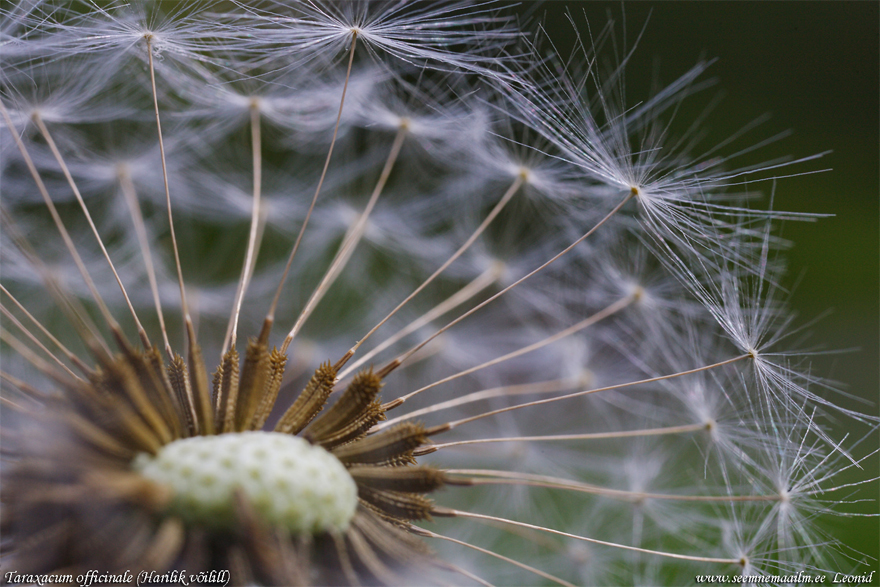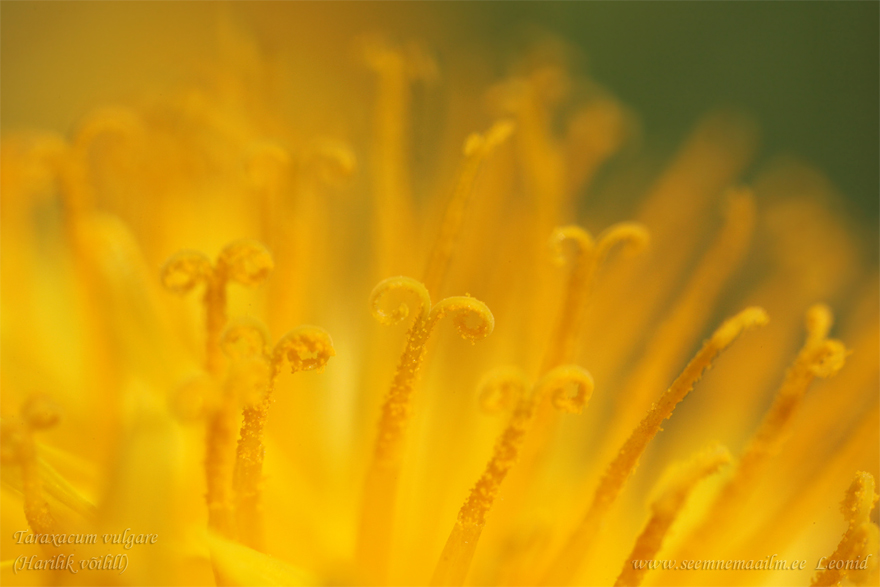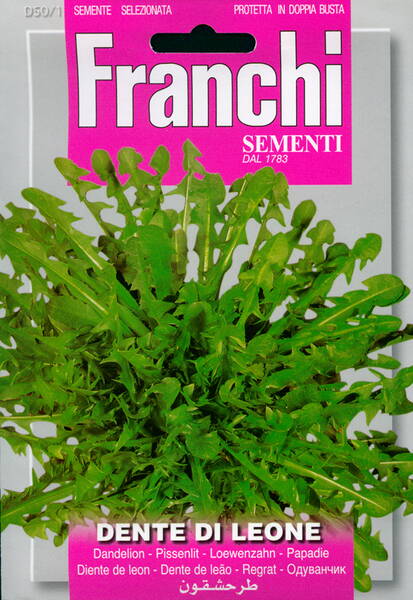Perennial herbaceous plant up to 30 cm high, with a sparsely branched taproot about 2 cm thick and about 60 cm long.
The leaves of the dandelion are glabrous (bare), 10-25 cm long, 1.5-5 cm wide, collected in a basal rosette.
The flowering scape is juicy, cylindrical, hollow inside, ending in a single basket of bisexual bright yellow ligulate flowers with a diameter of up to 5 cm.
The fruits are very light dry achenes, attached by a long thin stalk to parachute tufts. The seeds are attached to the receptacle loosely and are easily carried by the wind: the parachute seeds fulfill their mission exceptionally accurately (during flight, dandelion achenes do not sway or flip: they are always at the bottom, and upon landing, they are already ready for sowing).
The minimum germination temperature for achenes is +2+4 °C. Dandelion seedlings from achenes and shoots from buds on the root collar appear at the end of April and throughout the summer. Summer seedlings overwinter. Blooms in May-June. The maximum fertility of the plant is 12 thousand achenes, which germinate from a depth of no more than 4-5 cm.
Dandelion easily adapts to environmental conditions and survives successfully, enduring trampling and grazing. No other plants can stifle or displace it.
All parts of the plant contain thick white juice (latex), bitter in taste. Dandelion blooms in May-June, sometimes autumn flowering is observed.
Dandelion flower baskets behave differently both during the day and depending on the weather. In the afternoon and in wet weather, they close, protecting the pollen from getting wet.
In clear weather, the inflorescences open at 6 am and close at 3 pm - thus, the time can be known quite accurately by the state of the dandelion inflorescences.
The milky juice of the dandelion contains taraxacin and taraxacerin, 2-3% rubber substances, and the inflorescences and leaves contain taraxanthin, flavoxanthin, vitamins C, A, B2, E, PP, choline, saponins, resins, salts of manganese, iron, calcium, phosphorus, up to 5% protein, which makes them nutritious products. Dandelion roots contain triterpene compounds: taraxasterol, taraxerol, pseudotaraxasterol, β-amyrin; sterols: β-sitosterol, stigmasterol, taraxol; carbohydrates: up to 40% inulin. As well as fatty oil, which includes glycerides of palmitic, melissic, linoleic, oleic, cerotic acids; rubber, proteins, mucus, resins, etc. Taraxanthin, flavoxanthin, lutein, triterpene alcohols, arnidiol, faradiol are found in flower baskets and leaves.
Dandelion roots belong to inulin-bearing plants, due to which, when roasted, they can serve as a coffee substitute. This also includes Jerusalem artichoke tubers, chicory roots, and elecampane roots.
Dandelion roots collected in summer are unsuitable for use - they provide low-quality raw materials. During harvesting, the roots are dug up manually with a shovel or pitchfork. On dense soils, the roots are much thinner than on loose ones. Repeated harvesting in the same place is carried out no more often than every 2-3 years.
The dug-out dandelion roots are shaken off the earth, the aerial part and thin lateral roots are removed, and they are immediately washed in cold water. Then they are wilted in the open air for several days (until the milky juice stops flowing when cut).
Drying is standard: in attics or in a room with good ventilation, but best of all in a thermal dryer heated to +40+50 °C. The raw materials are laid out in a layer of 3-5 cm and turned periodically. The end of drying is determined by the brittleness of the roots. The yield of dry raw materials is 33-35% of the weight of freshly collected ones. Shelf life is up to 5 years.

Medicinal properties.
* Dandelion has a choleretic, antipyretic, laxative, expectorant, calming, antispasmodic, and mild hypnotic effect.
* An aqueous infusion of dandelion roots and leaves improves digestion, appetite, and general metabolism, enhances milk secretion in nursing women, and increases the general tone of the body.
* Dandelion is recommended for diabetes, as a tonic for general weakness, and for the treatment of anemia.
* Powder from dried dandelion roots is used to enhance the excretion of harmful substances from the body through sweat and urine, as an antisclerotic agent, for gout, and rheumatism.
* Decoction and thick extract are used as a bitter to enhance the secretion of digestive glands and as a choleretic agent.
* Dandelion is used to treat hepatitis, cholecystitis, gallstone disease, jaundice, gastritis, colitis, cystitis, to improve appetite and digestion, for constipation, flatulence, and also as an anthelmintic.
* Fresh leaves and juice from leaves are recommended for the treatment of atherosclerosis, skin diseases, vitamin C deficiency, and anemia.
* Infusion of the herb together with the roots is used for various diseases of the liver and gallbladder, tumors, dropsy, urolithiasis, hemorrhoids. Infusion of the herb is used for vitamin deficiency, as well as for various skin diseases: rashes, acne, furunculosis.
* Dandelion is also used internally and externally for furunculosis, eczema, and skin rashes. Oil tincture of dandelion roots is used as a remedy for burns, and the milky juice of the plant is applied locally when removing warts and calluses.
For medicinal purposes, the root (Radix Taraxaci), leaves, herb, and juice of the dandelion are used. Leaves, herbs, and juice are harvested in June, and roots - in early spring or late autumn at the stage of leaf wilting (dried in dryers at a temperature of +40+50 °C).

Bot. syn.: Leontodon taraxacum L., Taraxacum vulgare Schrank.
Common names: lion's tooth, blowball, cankerwort, priest's crown, swine's snout, puffball, faceclock, pee-a-bed, wet-a-bed, monk's head.
The dandelion is known to everyone as one of the first flowers, covering meadows, glades, roadsides, and city courtyards with a bright yellow blanket of its inflorescences...
Noticing it, gardeners rush to get rid of it as a malicious weed, but few know about its benefits: the ancient Greeks knew about the medicinal properties of this bright plant, and in ancient Arab medicine, dandelion was used widely and variously.
The common dandelion has long been used for food by various peoples; it was consumed by both the ancient Chinese and the first settlers on the American continent.
Its young leaves are often used to make a salad, known commercially in Europe under the French name "pissenlit" (the leaves are immersed in salt solution for 30-40 minutes to significantly reduce their bitterness), and borscht; dandelion jam and wine are made from the flowers, "dandelion honey" is prepared from the opened buds, and a coffee substitute from roasted roots. Boiled leaves are consumed like spinach.
In the British Isles, wine from dandelion flowers has been made since ancient times, which is very popular in England and was praised by R. Bradbury in his novel "Dandelion Wine".
In some countries, dandelion leaves are fermented like cabbage, and spring leaves are marinated.
Common dandelion is also widely popular in folk cosmetics: a mask of its fresh leaves nourishes, moisturizes, and rejuvenates the skin, and an infusion of flowers whitens freckles and age spots.
In Chinese folk medicine, all parts of the plant are used to this day as an antipyretic and general tonic.















